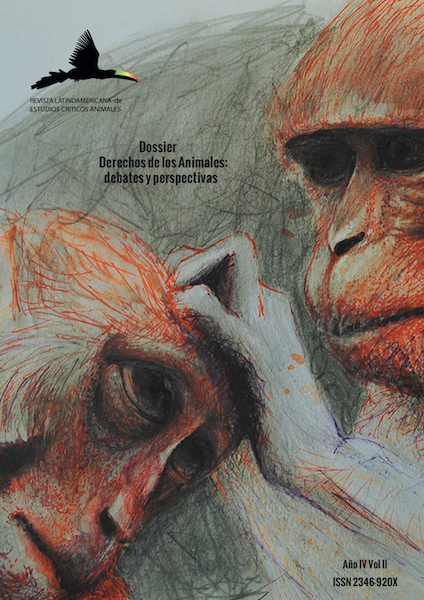About the sixth extinction (II)
From domestication to the sixth extinction
Keywords:
Anthropocene, domestication, agriculture, religion, legitimatizationAbstract
This second research work on the sixth extinction (and II) firstly show (1) some hypothesis which enable tracking its roots back to Neolithic agro practices, then this paper concisely explains some of the consequences derived from domestication of undomesticated species and their diversity. Following that, (2) the paper discusses Cauvin hypothesis on mental revolutions and religious-based and anthropomorphic symbolic rearrangements as causes for agriculture and domestication of nature. After (3) proposing counter-arguments against this mentalist hypothesis through Darwinian framework which entitles domestication to a symbiotic and co-evolutional relation, (4) one tries to read Cauvin thesis in terms of reasons which legitimate domestication religiously instead of causes that originate it, including some Pentateuch textbook that illustrate this religious justification on agricultural productivity.
In (5) the philosophical legitimization of natural domestication is explained through excluding dichotomies like a justification of the status quo, crystallised in the Neolithic revolution. Afterwards (6) the text invokes some arguments that link these philosophical dichotomies to addiction, fears and obsessions derived from pathologies of development, so finally (7) to relate the sixth extinction with childhood fantasies of omnipotence. At the end, we shall interpret a text from Civilization and Its Discontents in which Freud connects religious gods with civilizing process attached to total nature domestication and to the disappearance of the dangers representing all that is wild.
References
Aristóteles (trad. en 1988). Política, Valdés (traductor), Madrid: Gredos.
Banning, E. (2011). So Fair a House: Göbekli Tepe and the Identification of Temples in the Pre-Pottery Neolithic of the Near East. Current Anthropology, 52 (5), 619-660. doi: goo.gl/U3Bd52
Benyus, J. M. (2012). Biomímesis, Barcelona, España: Tusquets Editores S.A.
Budiansky, S. (1992). The Covenant of the Wild: Why Animals Chose Domestication, New Haven: Yale University Press.
Carrington, E. (31 de agosto de 2016). How domestic chicken rose to define the Anthropocene. The Guardian. Recuperado de www.theguardian.com/environment/2016/aug/31/domestic-chicken-anthropocene-humanity-influenced-epoch
Cauvin. J. (1994). The Births of Gods and the Origins of the Agriculture, Cambridge: Cambridge University Press.
Darwin, Ch. (1868). The variation of animals and plants under domestication, London, United Kingdom: John Murray.
Diamond, J. (mayo de 1987). The Worst Mistake in the History of the Human Race. Discover. Recuperado de: goo.gl/M8zLN4
Diamond, J. (2002). Evolution, consequences and future of plant and animal domestication. Nature, 418, 700-707. doi: goo.gl/tgykPw
Ehrenfeld, D. (1981). The Arrogance of Humanism, Oxford: Oxford University Press.
FAO (2006). Livestock's Long Shadow: Environmental Issues and Options. Recuperado de: http://www.fao.org/docrep/010/a0701e/a0701e00.htm.
Freud, S. (trad. 1993). El malestar en la cultura, Barcelona, España: Orbis.
Fromm, E. (1964). Anatomía de la Destructividad Humana, México: Fondo de Cultura Económica.
Glikson, A. (2014). Evolution of the Atmosphere, Fire and the Anthropocene Climate Event Horizon, Canberra: Springer.
Gould, S. J. (2006). El pulgar del Panda, Barcelona, España: Crítica.
Haskell, D. G. (2014). En un metro cuadrado de bosque: Un año observando la naturaleza. Madrid, España: Turner Noema.
Heidegger, M. (trad. en 1994). La Pregunta por la Técnica. En Conferencias y Artículos (pp. 9-37). Madrid, España: Ediciones del Serbal.
Maissels, Ch. (1990). The Emergence of Human Civilization, Cambrige: Cambridge University Press.
Plumwood, V. (1993). Feminism and The Mastery of Nature, London: Routledge.
Rindos, D. (1984). The Origins of Agriculture: An Evolutionary Perspective, Orlando, Florida: Academic Press.
Ruddiman, W. (2003). The Anthropogenic Greenhouse Era Began Thousands of years ago. Climatic Change, 61 (3), 261–293. doi: goo.gl/Yfpji9
Shepard, P. (1967). Man in the Landscape: A Historic View of the Esthetics of Nature. New York City, New York: Knopf.
Shepard, P. (1982). Madness and Nature. San Francisco: Sierra Club Books.
Shepard, P. y Sanders, B. (1992). The Sacred Paw: The Bear in Nature, Myth and Literature. San Francisco: Arkana.
Schmidt, K. (2010). Göbekli Tepe—the Stone Age Sanctuaries: New results of ongoing excavations with a special focus on sculptures and high reliefs. Documenta Praehistorica, 37, 239–256. doi: goo.gl/zxWjtS
Schoekel, L. A. (1993). Biblia del Peregrino, Estella: Ediciones Cristiandad.
Thoreau, H.D. (1998). Walden o La Vida en los Bosques, México: Editorial del Tomo.
Tudge, C. (2000). Neandertales, bandidos y granjeros. Cómo surgió realmente la agricultura, Barcelona, España: Crítica.
Turcotte, M.M., Araki, H., Karp, D.S., Poveda, K y Whitehead, S.R. (2017). The eco-evolutionary impacts of domestication and agricultural practices on wild species. Phil. Trans. R. Soc. B, 372 (1712), 1-9. doi: goo.gl/BCKCZA
Zeder, M. A. (2012). The Domestication of Animals. Journal of Anthropological Research, 68 (2), 161-190. doi: goo.gl/By6Hgo
Downloads
Published
Issue
Section
License

This work is licensed under a Creative Commons Attribution-NonCommercial-ShareAlike 4.0 International License.
La Revista Latinoamericana de Estudios Críticos Animales con ISSN 2346-920X se adhiere a las diferentes iniciativas que promueven el acceso libre al conocimiento, por lo que todos los contenidos de la misma son de acceso libre y gratuito y publicados bajo la licencia Creative Commons, que permite su difusión pero impide la alteración de la obra e incluye siempre mención al autor/a y fuente.
Es decir, una licencia de tipo Atribución-NoComercial-SinObraDerivada.
Por ello, los correos electrónicos de los autores se encontrarán a disposición de los lectores, en caso de que deseen contactarlos personalmente.




